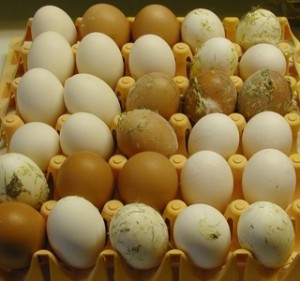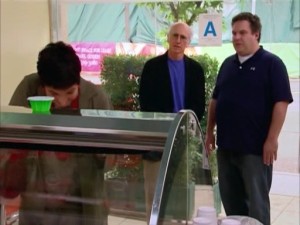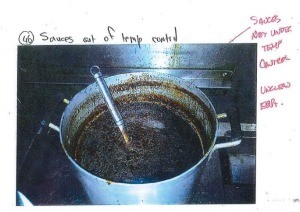Tomorrow is Melbourne Cup day, the (horse) race that stops a nation.
 It’s like the Kentucky Derby but nation-wide, and the hats are more outrageous.
It’s like the Kentucky Derby but nation-wide, and the hats are more outrageous.
The news has focused on fashion tips for Derby Day, but they should instead focus on tips for not barfing from raw egg-based dishes.
Two years ago on Melbourne Cup day, at least 220 people were felled by Salmonella and one was killed at Melbourne Cup functions in Brisbane, all linked to raw egg based dishes served by Piccalilli Catering.
In July 2015, at least 90 people were stricken with Salmonella after a fancy tea at the Langham Hotel in Melbourne. Australian health types confirmed it was Salmonella in raw-egg mayonnaise that was included in chicken sandwiches that were served at the $79 tea.
Fancy food ain’t safe food.
In Jan. 2015, at least 130 diners were stricken with Salmonella after being served ice cream containing raw eggs at Brisbane’s Chin Chin Chinese Restaurant. Dozens were hospitalized. Follow-up? Nothing
In May 2013, 160 diners at the Copa Brazilian restaurant in Canberra were struck down with Salmonella – it was the raw egg mayo that was then used in potato salad.
And so it goes.
The carnage continues from raw eggs in Australia (a table of known Australian-based is available at https://barfblog.com/wp-content/uploads/2015/03/raw-egg-related-outbreaks-australia-3-2-15.xlsx).
There are a few plausible explanations for the uniquely high number of Salmonella outbreaks related to raw egg dishes in Australia.
 There is a particular form of food snobbery that disses the use of pasteurized eggs in the food pornography biz, even though you could lose your restaurant and life savings to one dish. On those few occasions I go out to eat, I ask the server if the mayo or aioli is made with raw eggs. They always come back and insist, of course it is made with raw eggs, the chef wouldn’t have it any other way.
There is a particular form of food snobbery that disses the use of pasteurized eggs in the food pornography biz, even though you could lose your restaurant and life savings to one dish. On those few occasions I go out to eat, I ask the server if the mayo or aioli is made with raw eggs. They always come back and insist, of course it is made with raw eggs, the chef wouldn’t have it any other way.
Wrong answer.
In March, 2015, 250 teachers were stricken with Salmonella at a Brisbane conference, and an additional 20 people were sickened on the Gold Coast from the same egg supplier.
Some answers are now available, but only through access to information requests.
The Courier Mail reports this morning that a kitchen stick blender contaminated with Salmonella was the source of a mass food poisoning outbreak in Brisbane early this year.
About 250 people, mostly state school principals, fell ill and 24 people were admitted to hospital after eating at an education conference at the Brisbane Convention and Exhibition Centre in February.
Documents obtained by The Courier-Mail show that investigators examining the outbreak found bacteria on several kitchen utensils, with that bacteria “incubated’’ during the cooking process.
Test results from the investigation showed the people who fell ill were sick with the same strain of salmonella found on a kitchen stick blender “which demonstrates the source of the outbreak.”
Not quite. Salmonella has to get on the stick, whether it was introduced by humans or raw eggs or something else.
The documents rule out the possibility the outbreak was caused by eggs being contaminated before they arrived at the convention centre.
Wow.
“(Redacted) suggested that if the eggs were contaminated when they arrived, that this was the cause, however I advised … that poor cleaning and sanitising of the stick blender was the ultimate cause,’’ the documents say.
“(Redacted) questioned why the Sal. was not killed during the cooking process of the bread butter pudding. I advised that the QH microbiologist suggest that 140deg was not hot enough to kill Sal, but rather it was an incubation temp.’’
Brisbane City Council is now considering prosecuting the operators, with a decision due by the end of this year.
 Documents show the centre lost their five-star food safety rating from the council in the wake of the test results and they are yet to regain it.
Documents show the centre lost their five-star food safety rating from the council in the wake of the test results and they are yet to regain it.
A food safety audit found a “breakdown in cleaning and sanitising processes as indicated by the following positive swabs from 17/03/15”, with poor hand washing the reason for E. coli being found.
They found Salmonella on a larger robotic mixer and B. cereus on a smaller mixer, pastry brush and a whisk.
Convention centre general manager Robert O’Keeffe said the incident was the first of its type in the centre’s 20-year history.
That’s nice.
“Since the reported cases of illness, we have undertaken independent food safety audits, continued our testing processes for the sourcing, processing and delivery of safe food to our guests,” he said.
“All of our cooking practices and processes are monitored and recorded on our 24-hour computerised food safety monitoring system.”
He said the blender at the centre of the controversy had been removed and whole eggs taken off the menu.
“This means no eggshells, which potentially carry pathogens, will ever come into BCEC’s kitchens,” he said.
He said during the salmonella outbreak the eggs were not being sourced from their regular supplier.
I want pasteurized eggs used in mayo and aoili because this isn’t CSI and those UV goggles won’t tell a chef which egg has Salmonella.
In addition to popular culture, the chefs are merely responding to government advice.
Victoria Department of Health spokesman Bram Alexander said the Latham outbreak was a warning to cooks about the dangers of using raw eggs: “You have to store them properly, you have to handle them properly, prepare them properly, and don’t used cracked eggs.”
What the health spokesthingy wouldn’t say is: don’t serve dishes that contain raw eggs.
They say that in Canada and the U.S., but somehow, Australian regulators won’t directly say, don’t serve raw-egg containing dishes.
And that allows people like the Langham’s Melbourne managing director, Ben Sington, to say with a straight face, “we can confirm that all our eggs are sourced from a reputable and certified supplier and stored in accordance with food safety guidelines.”
A table of Australian egg outbreaks is available at https://barfblog.com/wp-content/uploads/2015/03/raw-egg-related-outbreaks-australia-3-2-15.xlsx.
 Nasir Butt had a “considerable lack of control” in the running of Santino’s in Loftus, Teesside Magistrates’ Court heard.
Nasir Butt had a “considerable lack of control” in the running of Santino’s in Loftus, Teesside Magistrates’ Court heard.









